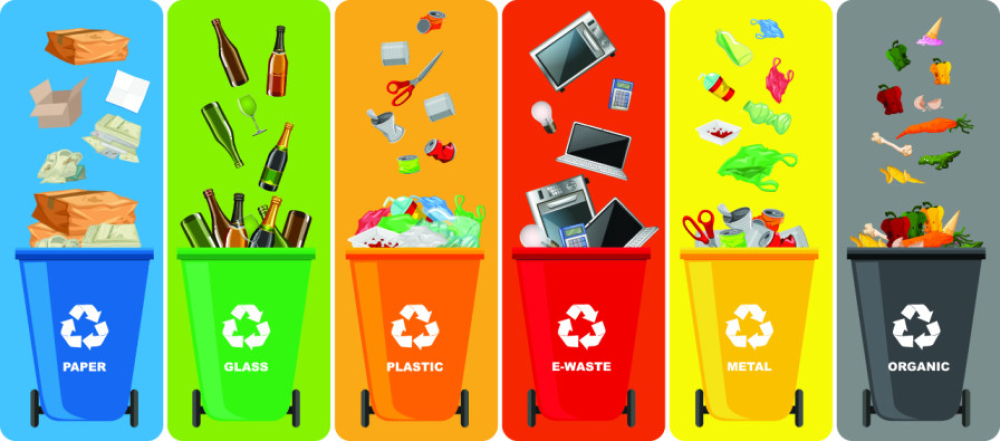Bin Blunders: Print and Wishcycling
03 May 2024

We all want to do the right thing regarding recycling, right? If you're reading this, then it's likely you're in the 90% of UK consumers who, when asked by Recycle Now, claimed to recycle household waste, including print daily or several times per week.
You can stop reading now if you're among the 4% who say they never recycle.
Where I live, we have four bins outside our house. It's a festival of bins. One has a blue lid for recycling, a brown lid for garden waste, a little green bucket thing for food waste, and a black lid for landfill. The landfill is narrower than the blue and brown ones, presumably encouraging us to recycle more. As a household, we'd like to think that we're good at recycling, but like most of us, we probably get it wrong regularly.
There are two blunders that UK consumers make when it comes to recycling. One is putting things in the recycling bin that can't be recycled, and the other is not recycling things that can be recycled.
The first phenomenon has a particular name – wishcycling.
"Wishcycling" is common with paper products when consumers are unsure whether an item is recyclable and choose to put it in the recycling bin on the chance that it might be processed. We wish it could be recycled, but it can't. The danger is that a "contaminated" recycling bin won't be collected, or the whole lot will go to landfill as it's too costly and time-consuming for the waste management company to sort through by hand.
So, what should we look for when recycling our print, paper and cardboard?
Firstly, it depends on where you live. Confusingly, local authorities have different rules around the country. However, there is a growing consensus that there needs to be the same rules wherever you live. Economies of scale mean that it would be far better for all councils to adopt the same rules – plus, there could be national awareness campaigns with a clear message.
Generally, these are paper and card products that can and can't be recycled at the curbside.
|
Yes, please |
No thanks |
|
Cardboard boxes (just remove any sellotape) |
Post-it notes (it's the glue in them) |
|
Newspapers |
Books – donate or lend them. |
|
Non-glossy Magazines (just remove the plastic film) |
Paper straws (not only are they hopeless as actual straws as they disintegrate, but you can't recycle them either). |
|
Loo roll tubes |
Cartons with plastic liners (although some local authorities will take Tetrapak – you have to check) |
|
Pizza boxes (just remove the pizza first) |
Paper towels |
|
Greetings cards (without glitter or shiny bits) |
Anything with glitter or laminate |
|
Leaflets and mail (even envelopes with windows) |
Paper coffee cups (plastic in the liner) |
|
Egg boxes |
Tubes with a metal bottom |
The worst-case scenario with Wishcyling is that not only does the whole contents of your (in my case, blue) recycling bin end up in a landfill, but the whole contents of the recycling bin lorry can, too.
Many local authorities send stickers that can go on your bins as easy reminders for which paper and print products should go in which bin.
As with everything, education is critical. It's our responsibility as environmentally conscious consumers to check before we recycle. Some countries hand out hefty fines to consumers who wishcycle or get it wrong. Others slap a big sticker of shame on your bin for all your neighbours to see.
The UK organisation Recycle Now is leading the charge against widespread confusion in the UK by seeking to standardise the advice across the country and to simplify the message.
Let's look at how our fellow recyclers worldwide deal with the issue.
USA—You'll get tagged if you get it wrong in some states. The waste collection company will stick a tag on your curbside waste, partially as a deterrent but also with an educational message about what can and can't be recycled. Interestingly, the US has some of the world's lowest household waste recycling rates, at approximately 32%!
Germany – Some of the world's highest household waste recycling rates in Germany. A "Green Dot" system operates whereby the producers of the print materials are the ones who pay for the recycling – it's therefore well funded. Most German households have a good level of understanding of what can and can't be recycled.
Australia - similar to the US, Australians have an issue with wishcycling and the knock-on effect of the contaminated bins being left uncollected, with an educational note attached.
Japan - the Japanese are the standard-bearers when it comes to this issue. Residents and businesses must sort their waste into several categories for easy recycling and processing. Compliance levels are extraordinarily high, and fines are astronomical for getting it wrong. Japanese culture also abhors litter and mess, contributing significantly to a successful system and high recycling rates.
Sweden - Sweden is known for its efficient waste management systems, with extensive recycling and waste-to-energy programs. The Swedish government encourages manufacturers to produce recyclable and environmentally friendly products. Public education campaigns are frequent, aiming to reduce wishcycling by informing residents about proper recycling practices.
We could be doing the same as Japan and Sweden if the UK rules were standardised and the budget was put into an educational programme. UK consumers are seeing major supermarkets using less packaging. The campaigns run by Recycle Now are trying to bring clarity to the situation. Still, this success lies with individual consumers stopping and thinking a bit more when dealing with waste print, paper and recycling in general.
Written by Chris Rothwell - The Letterbox Consultancy

1.png)


Please login to comment.
Comments